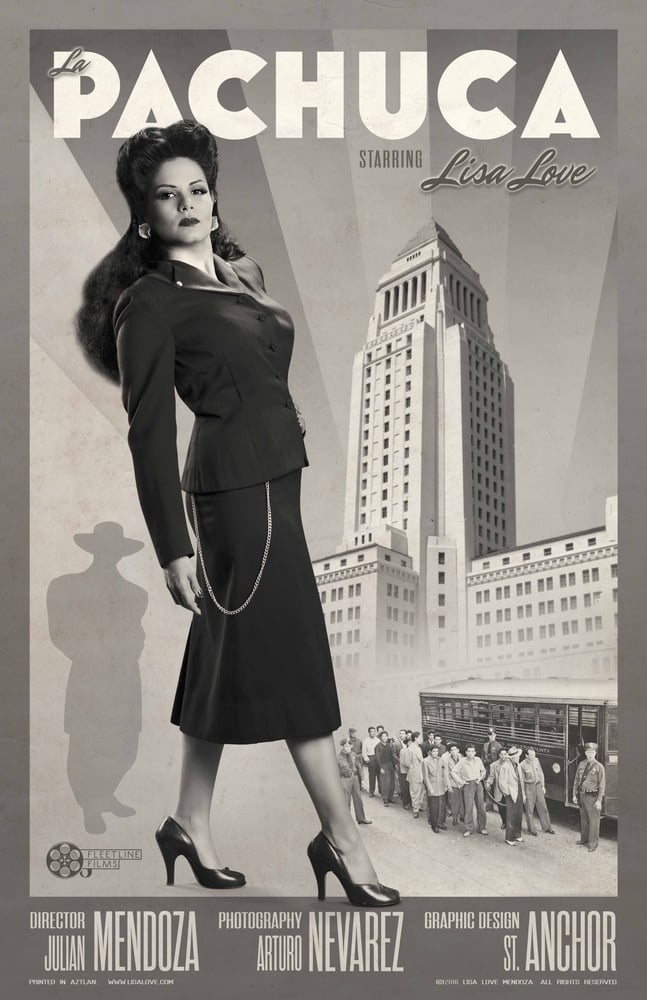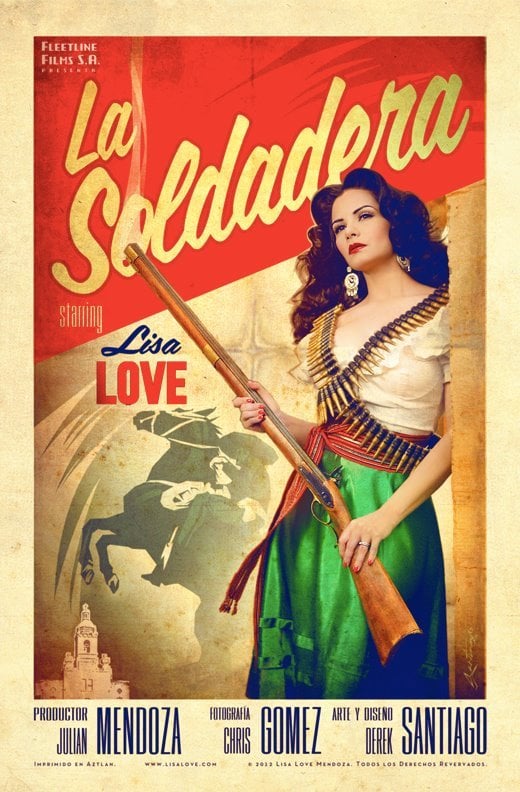La Pachuca
$20.00
"La Pachuca" a tribute to the Zoot Suiter
11x17 Poster Print featuring Lisa Love.
Model Lisa Love Mendoza www.LisaLove.com
Photography by Arturo Nevarez www.ArtsPhotos.net
Graphic Design by Stephan Kaeding www.StAnchor.de
Shipped via USPS.
©Lisa Love Mendoza. All Rights Reserved
------
Zoot Suiters and Pachucas
Written by Julian Mendoza
www.FleetlineFineArt.com
Zoot Suiters were named after of the type of suits they wore. The Zoot Suit was a modified-exaggerated version of the suit cut of that time (the late 1930s to 1940s). It is said that the word “Zoot” came from the jazz scene back in the day. Whether the music and movie industries influenced the streets, or the streets influenced those industries, is debatable. I tend to think it was both. I do know from having the opportunity to speak to Original Zoot Suiters in my family and extended family and friends, that by the late 1930s the Zoot Suit had taken root in the streets of Los Angeles, California. Nobody embraced the Zoot Suit or the lifestyle that came with it, like the Chicano youth in the barrios of L.A.
For the early Zoot Suiter, it was a matter of buying a suit off the rack a size or two larger than they wore, and going straight to the tailor to get it altered to give it the desired drape shape. By the early 1940s the guys would save up their money and go Downtown to get a custom made Zoot Suit. Whether it was double breasted, single breasted, or a one button roll, they all had “the look”. From the wide padded shoulders and wide peaked lapels on a long coat, to the high waisted, extra deep pleated pants with wide legs, pegged at the bottom and stuffed into a cuff. Sometimes the look was finished off with a wide brim hat, or an extra long key or watch chain, depending on the mood. From what I’ve heard, the longer the coat, the higher the waist, the wider the leg, and the tighter the cuff... the harder they were. As you can tell, the Zoot Suiter also known as “Pachucos”, unlike the generation before them were not trying to blend in. They, along with their female counterparts, “Pachucas”, stood out and got a lot of attention, most of which was negative.
Due to the racial climate of the time, it wasn’t easy being young and brown in L.A. in the 1940s, looking that sharp came with a price. This became evident with the infamous unconstitutional Sleepy Lagoon Trial in August of 1942. Then the tension became uncontrollable in June of 1943 when the U.S. Government put out a Green Light on all brown youths wearing Zoot Suits. They sent the Military into certain L.A. areas to find and beat these young men (without any legal consequences or ramifications). Los Angeles would come to know this event as the ZOOT SUIT RIOTS. For some of the U.S. servicemen and Law Enforcement, beating the Zoot Suiters, cutting their hair, cutting up their suits and leaving them naked in the streets wasn’t enough. Some of these U.S. Military men proceeded to sexually assault and rape the girlfriends and wives of these Zoot Suiters. To those who were there, it was clear that The Zoot Suit Riots were never about the suits. What always struck me about that crazy time, was that almost all of those Chicano Zoot Suiters eventually ended up joining those same Armed Forces and helped this country win World War II.
Pachucas were the female counterpart of the Pachuco. It is said that the origin of this word comes from a border town in the southwest region of the U.S. The word “Pachuco” and “Pachuca” do not have their roots in the Spanish language, but from the Native language that was originally spoken in this area. The Pachucas proudly stood side by side with their Zoot Suited brothers, boyfriends, and husbands.
The Pachuca had a distinct style that ranged from a casual look that sometimes consisted of an above the knee skirt, with a sweater or coat, with high black socks and sandals, to a dressier more polished look, which sometimes consisted of a beautifully tailor-made gaberdine skirt suit. These tailored suits often times were designed to match their Zoot Suiter boyfriends or husbands. That dressier look was heavily influenced by the glamorous movie stars on the silver screen of that time. Whether they were casual or dressy, the Pachucas wore their signature extra high Pompadour, a popular hairstyle of the time in which the hair is swept back high off the face.
The Pachucas were subject to the same racial challenges of that time, that their Zoot Suiter men experienced. This often lead to them being the victims of beatings, sexual assaults, and rapes by the hands of law enforcement and the U.S. Military. If it wasn’t challenging enough dealing with the social injustice aimed towards women in general, being young, brown and having a rebellious attitude, willing to fight if necessary, made things even more difficult for these tough women. Despite what many of these young woman had been through, they went on to survive this difficult period in our Chicano history.



